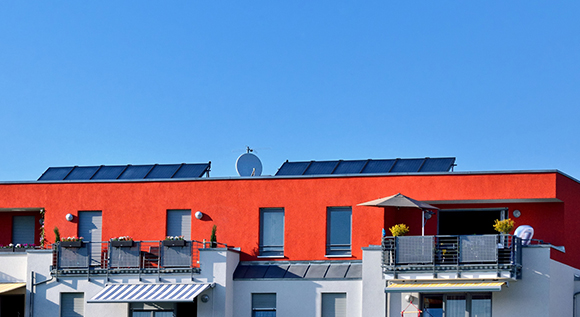Minister Zypries: "Support for landlord-to-tenant power supply makes tenants part of the energy transition"
On 26 April 2017, the Federal Government approved draft legislation for supporting landlord-to-tenant power supply.
 © fotolia.com/reimax16
© fotolia.com/reimax16
It is likely that photovoltaic power supplied by landlords to their tenants will become eligible for funding before the end of this year. On 27 April 2016, the Federal Cabinet adopted draft legislation to this effect. The proposal had been tabled by the Federal Ministry for Economic Affairs and Energy. Said Economic Affairs Minister Brigitte Zypries: "This funding for landlord-to-tenant power supply will take the energy transition to urban areas and make tenants part of the energy transition". Up until now, it has mainly been homeowners who can benefit from generating their own electricity in rooftop installations. The new legislation is to allow tenants to do the same.
The reason why this has so far not been an option is that it has not been economically viable. This is due to higher costs for billing, selling, and metering associated with the landlord-to-tenant model. Minister Zypries said: "We are introducing a landlord-to-tenant supply premium, which will close this gap. This will stimulate supply, benefit tenants, and result in a faster increase in the share of solar energy being used."
Landlord-to-tenant electricity supply means that landlords supply their tenants with electricity generated in a PV system installed on the rooftop of the building or in a CHP unit that is also installed locally. This has the advantage of eliminating grid charges and grid surcharges. The electricity thus supplied is also exempt from electricity tax and concession fees. It is however not exempt from the renewable energy surcharge (EEG surcharge). A study conducted on behalf of the Federal Ministry for Economic Affairs and Energy has found that up to 3.8 million households could benefit from this type of electricity supply.
Tenants are free to choose whether they want to buy electricity from their landlords or not
Under the draft legislation, tenants would be free as to whether they want to buy electricity from their landlords or not. This is to ensure that landlords operating solar installations sell this electricity at competitive prices. For the same reason, the contract for the electricity supply must not be part of the rental agreement. The contract for electricity supply expires after one year. Moreover, it is completely separate from the rental agreement and can be ended separately. The draft legislation sets out a maximum price for landlord-to-tenant electricity, which is equivalent to 90% of the rate charged by the default utility. Contracts must be designed in a way that ensures that tenants have a reliable supply of electricity, including at times when the landlord cannot supply any, for instance because the sun is not shining.
Funding rates will be set in line with the "breathing cap"
The solar installation can be operated either by the owners themselves, or by a third party commissioned by the owners. In addition to the electricity price paid by the tenants for the electricity supplied to them, the installation's operator will also receive a premium as set out in the Renewable Energy Sources Act (EEG). The amount of this landlord-to-tenant supply premium will depend on the installation's capacity and the overall PV capacity added in Germany, and will probably stand at between 3.8 and 2.75 cents per kilowatt hour. The exact amount will be set following the principle of the breathing cap (click here to find out more). Any electricity generated that is not used up by the tenants will be fed into the public grid in return for remuneration in line with the rules set out in the Renewable Energy Sources Act.
New capacity limited to 500 megawatts per year
Landlord-to-tenant electricity supply is subject to the renewable Energy Sources Act surcharge. This is important given that the revenue from this EEG surcharge is used to fund the expansion of renewables capacity. If landlord-to-tenant electricity supply were exempt from the surcharge, this would result in higher costs for everyone else, including many tenants. It is for this same reason that the overall volume of landlord-to-tenant electricity supply that can be added each year will be limited to 500 megawatts. This is to protect all those that cannot or do not want to purchase electricity from their landlords. It prevents prices from rising excessively and serves to ensure a good financial basis for the energy transition.

